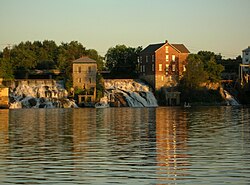Vergennes, Vermont
| Vergennes, Vermont | ||
|---|---|---|
| City | ||

Vergennes
|
||
|
||
| Nickname(s): Little City on the Falls | ||
 Location in Addison County and the state of Vermont. |
||
| Coordinates: 44°9′56″N 73°15′8″W / 44.16556°N 73.25222°WCoordinates: 44°9′56″N 73°15′8″W / 44.16556°N 73.25222°W | ||
| Country | United States | |
| State | Vermont | |
| County | Addison | |
| Incorporated as a city | 1788 | |
| Government | ||
| • Mayor | William Benton | |
| Area | ||
| • Total | 2.5 sq mi (6.5 km2) | |
| • Land | 2.4 sq mi (6.2 km2) | |
| • Water | 0.1 sq mi (0.3 km2) | |
| Elevation | 194 ft (59 m) | |
| Population (2010) | ||
| • Total | 2,588 | |
| • Density | 1,141.1/sq mi (440.6/km2) | |
| Time zone | Eastern (EST) (UTC−5) | |
| • Summer (DST) | EDT (UTC−4) | |
| ZIP code | 05491 | |
| Area code | 802 Exchange: 877 | |
| FIPS code | 50-74650 | |
| GNIS feature ID | 1460018 | |
| Website | www.vergennes.org | |
Vergennes /vərˈdʒɛnz/ is a city located in the northwest quadrant of Addison County, Vermont. The municipality is bordered by the towns of Ferrisburgh, Panton and Waltham. As of the 2010 census the city population was 2,588. It is the smallest of Vermont's nine cities in terms of population, though the city of Winooski covers a smaller area. It was the first city chartered in the state of Vermont.
Vergennes, first settled in 1766 by Donald MacIntosh, was established in 1788, the only one of Vermont's cities not to have been first chartered as a Town or independent village. Instead, portions of the pre-existing Towns of New Haven, Panton and Ferrisburg, where they intersected at the Otter Creek Falls, were split off to form Vergennes. It is the smallest city (by population) in Vermont.
The city is named for Frenchman Charles Gravier, Comte de Vergennes, who greatly aided the rebel colonial effort in the American Revolutionary War. His hatred of the British and his desire for revenge after the French defeat in the French and Indian War (the North American front of the Seven Years' War won by the British), led him to support the American rebel colonists by arranging to send them arms and troops to the revolutionary cause. He worked with Beaumarchais to secretly procure arms and volunteers and get them to the Americans. As directed by Louis XVI, Gravier established a dummy company through which the Americans received nearly 80% of their military supplies from France. At the close of the war, Gravier negotiated the 1783 Treaty of Paris, which formally established peace between the United States and Britain.
...
Wikipedia

